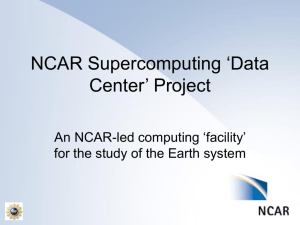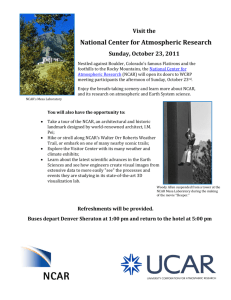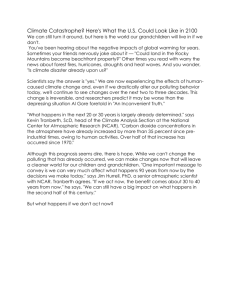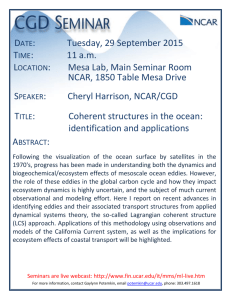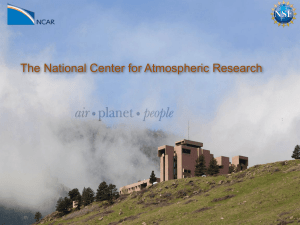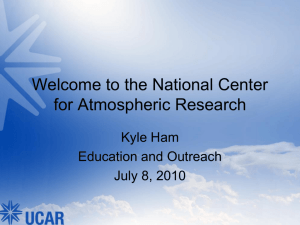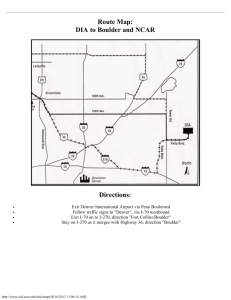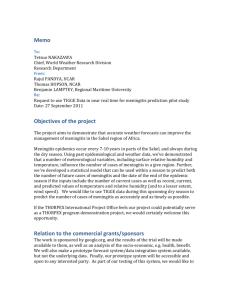Terra-Lab 2010
advertisement
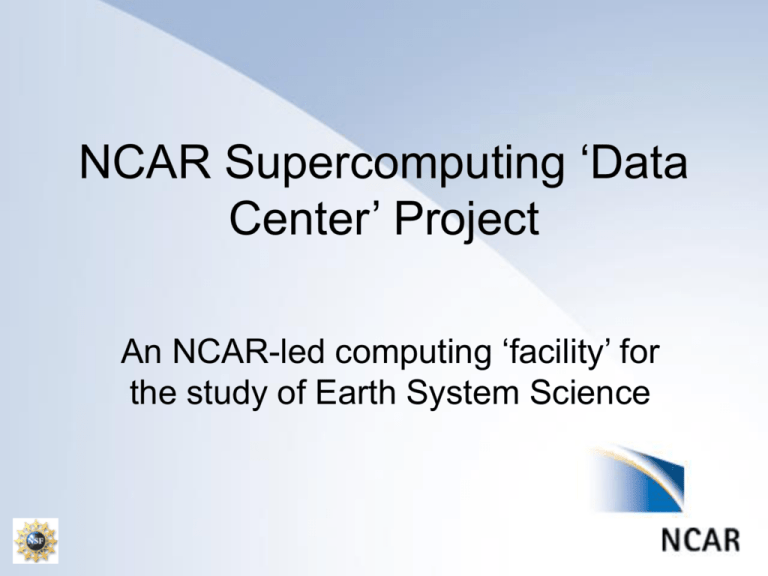
NCAR Supercomputing ‘Data Center’ Project An NCAR-led computing ‘facility’ for the study of Earth System Science Outline • A Problem • An Opportunity – NSF’s Petascale Roadmap • A Solution – Facility Proposal: Site and Cost – Partners • The Scientific Payoff • Next Steps – Schedule and Panels NCAR Leadership in Supercomputing… • One of the founding missions of NCAR was: “… to provide, or arrange for provision of facilities for the scientific community as a whole that whose initial cost and upkeep lie beyond the capability of individual universities or research groups.” – Preliminary Plans for a National Institute for Atmospheric Research. 1959 – NCAR Blue Book • Note: the wording does not imply physical collocation. • This mission does confer a responsibility that cannot be delegated - namely maintaining an complete integrated cyberinfrastructure (CI) system for modeling and data analysis that meets our scientific community’s needs. Examples of NCAR simulation science today • • • • • • Global change climate ensembles Weather Research Forecast Geophysical Turbulence Fire storm front modeling Space weather More… A problem • NCAR Mesa Lab computer facility is quickly becoming obsolete • Power, cooling and floor space will be inadequate beyond the next procurement • Science is being restricted by focusing on capacity ahead of capability CMOS Trends Continue … Chips: Faster, Cheaper but Hotter An Opportunity NSF’s Petascale Roadmap “Overarching Recommendation: Establish a Petascale Collaboratory for the Geosciences with the mission to provide leadership-class computational resources that will make it possible to address, and minimize the time to solution of, the most challenging problems facing the geosciences.” www.joss.ucar.edu/joss_psg/meetings/petascale/ NSF Conclusions • NSF is committed to developing and implementing a strategic plan for cyberinfrastructure – Broad based plan involving the university, Federal agencies, vendors, and International partners • ATM, OCE, and EAR take different approaches to the realization of CI for their discipline – Dependent on the readiness of the community • Petascale facility is an integrating theme for the Geosciences community – High potential for the generation of new knowledge and paradigm for the conduct of research – Building and sustaining a petascale facility will be a significant challenge to budgets and technology – Consistent with NSF strategic vision for CI A solution for NCAR • A new computing facility (not at the Mesa Lab) • Extensive investigations, working with consultants and internal needs resulted in a detailed set of options • Provides for 5-20 years of computing (capacity and capability) diversity based on current and predicted future trends in CMOS technology • Allows NCAR to reach beyond its current research scope The facility needed • Data Center Expansion Report from NCAR’s Computing and Information Systems Lab • 20,000 (initial to 60,000) sq. ft. of (8ft) raised floor computer room • 150,000 sq ft. (gross) building area • 4 (to 13) MW power + generators • Cooling, etc. • On 13 acres (20 year lifetime) • Accommodates computers, staff, open space, initial and future requirements Birds Eye View Architectural View Phase 2 Addition Phase 3 Addition Importance of Site Selection • Limited selection of sites that meet criteria – Size (10-15 acres) – Electrical capacity (up to 24 MW) – Fiber optic route (dark fiber) • Investigated – – – – Marshall Louisville Longmont Westminster (Water, Political Complications, Fiber Optics) (Electrical Capacity) • New partners and options are now being sought – – – – – IBM Colorado School of Mines Colorado State University University of Colorado University of Wyoming Cost Drivers • Primary Drivers – Tier III Reliability • Mechanical Systems • Electrical Systems – Engineering • Secondary Drivers – Building Size – Land Site • • • • Facility - up to $75M (one time) Operations - ~ $15M/year (2Xpresent) Computing increments - $15M/year (2Xpresent) Computing infrastructure - $5M/year (new) The Scientific Payoff… A petascale computer will enable scientists to … • Do credible regional climate modeling for decision support. Requires resolving individual mountain ranges and ocean western boundary currents. • Model climate and weather in a fully coupled mode. • Better understand the marine biogeochemical cycles. Requires resolving ocean mesoscale eddies. • Accurately simulate the dynamical, microphysical and radiative cloud processes. • Improve seismic predictions and understand the structure of the inner core as well as the fine structure of the lower mantle. A petascale computer will enable scientists to • Perform new research in solid earth and environmental engineering • Assimilate thousands of earthquakes bringing the fine structure of the Earth’s mantle and inner core into focus. • Study the physical basis of land surface parameterizations by modeling soils, topography and vegetation at sub-meter scales. • More accurately predict the damaging effects of solar flares on satellites and power distribution systems by resolving the fine structure of the corona magnetic field. • Investigate energy management applications Science examples … Hurricane Katrina Reflectivity at Landfall 29 Aug 2005 14 Z 4 km WRF, 62 h forecast Mobile Radar Main Points • Huge scientific discoveries await geoscience modelers at 1 PFLOPS and beyond. • CMOS continues to get hotter and cheaper. The most recent acquisition tracks this trend. • Every center is (or will be) facing facility challenges in the race to these discoveries. This situation is NOT unique to NCAR. • NCAR now has a facility plan, that if successful, uniquely positions it as a world leader in geoscience simulation. • The new facility is not a crisis: it is an opportunity. The Opportunity • Understanding of fundamental physical processes in the Sun-Earth system • Environmental and Energy applications not yet possible • NCAR and partners will scope/define these options – Such a facility would be a computational equivalent of the Hubble Telescope for geoscience simulation. Next Steps NSF Geosciences Community Draft Version 1 UCAR/ATM Universities NSF OCN and EAR Universities NSF Geosciences Research Programs (ITR,OCI) The Geosciences Research Consortium Geoscience Domain Partner Geoscience Domain Partner NSF Geosciences Capability Center Geoscience Domain Partner Geoscience Domain Partner NCAR + Facility Partner Somewhere near Boulder Geoscience Domain Partner Geoscience Domain Partner The Schedule • Formed NCAR project committee • Forming Blue Ribbon Panel and hold teleconference Oct. 17 2005, meet mid-Nov. • Project plan development Oct-Dec • Community engagement - Nov-Jan • Formalize partnerships - Oct-Dec • Present initial plan to National Science Foundation, late-October, 2005 • Forge international collaborations - Nov. 2005 • Complete project plan - Feb. 2005 • Initiate facility - June 2006? • First electrons - June 2008 - March 2009? Contacts at NCAR • Tim Killeen (killeen@ucar.edu) - NCAR Director • Lawrence Buja (southern@ucar.edu) and Peter Fox (pfox@ucar.edu) are co-chairs of the NCAR project team • Aaron Anderson (aaron@ucar.edu) is the computing facilities contact • Jeff Reaves (jreaves@ucar.edu) is the financial/ contracts contact Concluding remarks …
